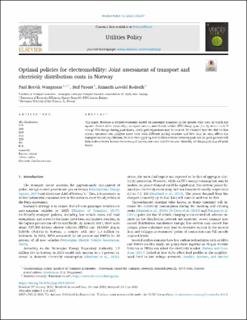| dc.contributor.author | Wangsness, Paal Brevik | |
| dc.contributor.author | Proost, Stef | |
| dc.contributor.author | Rødseth, Kenneth Løvold | |
| dc.date.accessioned | 2022-01-21T09:02:20Z | |
| dc.date.available | 2022-01-21T09:02:20Z | |
| dc.date.created | 2021-08-24T09:27:45Z | |
| dc.date.issued | 2021 | |
| dc.identifier.citation | Utilities Policy. 2021, 72 1-11. | |
| dc.identifier.issn | 0957-1787 | |
| dc.identifier.uri | https://hdl.handle.net/11250/2838604 | |
| dc.description.abstract | This paper develops a stylized economic model for passenger transport in the greater Oslo area, in which the agents' choices of car ownership, transport pattern, and electric vehicle (EV) charging are jointly determined. If enough EVs charge during peak hours, costly grid expansions may be needed. We examine how the distribution system operators can mitigate these costs with different pricing schemes and how this, in turn, affects the transport market equilibrium. We find that applying tariffs differentiated between peak and off-peak periods will help strike a better balance between grid investment costs and EV-owners’ disutility of charging during off-peak hours. | |
| dc.language.iso | eng | |
| dc.title | Optimal policies for electromobility: Joint assessment of transport and electricity distribution costs in Norway | |
| dc.type | Peer reviewed | |
| dc.type | Journal article | |
| dc.description.version | publishedVersion | |
| dc.source.pagenumber | 1-11 | |
| dc.source.volume | 72 | |
| dc.source.journal | Utilities Policy | |
| dc.identifier.doi | 10.1016/j.jup.2021.101247 | |
| dc.identifier.cristin | 1928214 | |
| dc.relation.project | Norges forskningsråd: 255077 | |
| dc.relation.project | Norges forskningsråd: 107957 | |
| cristin.ispublished | true | |
| cristin.fulltext | original | |
| cristin.qualitycode | 1 | |
